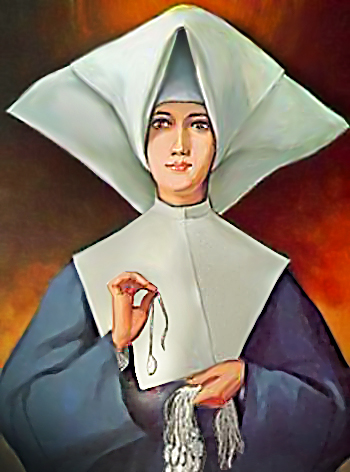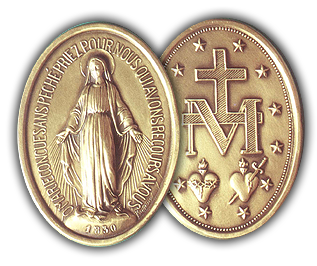St. Catherine and the Miraculous Medal
 The first apparition came on the eve of the feast of St. Vincent at the Motherhouse. The mother superior had given each of the novices a piece of cloth from the holy founder’s surplice (vestment). Catherine Labouré prayed earnestly to St. Vincent that she might, with her own eyes, see the Mother of God. That night her prayer was answered. An angel, with the voice of a little girl, awoke Catherine from her sleep, saying:
The first apparition came on the eve of the feast of St. Vincent at the Motherhouse. The mother superior had given each of the novices a piece of cloth from the holy founder’s surplice (vestment). Catherine Labouré prayed earnestly to St. Vincent that she might, with her own eyes, see the Mother of God. That night her prayer was answered. An angel, with the voice of a little girl, awoke Catherine from her sleep, saying:
“Sister Labouré, come to the chapel…the Blessed Virgin is waiting for you.”
Who Was St. Catherine?
Catherine was born circa 1811 as the eighth child of a family of 10. Her mother, Madeleine, died at 42 years of age when Catherine was 9 years old. It was at this moment that Catherine sought refuge in the boundless love of Mary, and received her First Communion at the age of 11 on January 25, 1818. From that day on, she rose at 4 a.m. and walked several miles to assist at Mass, and to pray for grace and strength before the start of her day’s work. Her only desire was to give herself without reserve to the Lord. Never was the thought of the Lord far from her mind.
Becoming a Daughter of Charity
Catherine’s older sister (Louise) was a Daughter of Charity, and Catherine was in contact with the Sisters at the Hospice of Moutiers-Saint-Jean. She was then 22 years old. Being so near the Daughters of Charity, she thought about entering that Community. The time had come for Catherine to talk to her father about her vocation. He flatly refused and sent her to Paris to work in a middle class restaurant hoping that it might make her change her mind. But she maintained her resolve to follow her vocation.
After much hesitation, her father finally gave his consent. On April 21, 1830, Catherine began her Seminary (novitiate) at the Motherhouse in the Rue du Bac in Paris. It was there in the chapel that Catherine was blessed with the apparitions of Our Lady to which we owe the Miraculaous Medal.
Vision of Mary
When Catherine went to the chapel at the Mother House at the Rue du Bac in Paris, she found it ablaze with lights. Quietly, she approached the sanctuary that was filled with radiance as if consumed in fire and knelt at the communion rail. She felt the presence of another person near her. When she lifted her head from prayer, the Blessed Virgin, in a blaze of glory, sat in a chair just beyond Catherine’s reach. Catherine rose, went over and knelt, resting her hands in the Virgin’s lap. Mary placed her arms around Catherine and said: od wishes to charge you with a mission. You will be contradicted, but do not fear; you will have the grace. Tell your spiritual director all that passes within you. Times are evil in France and in the world.” A pained expression crossed the Virgin’s face.
“Come to the foot of the altar. Graces will be shed on all, great and little, especially upon those who seek them. Another community will become large; you will have the protection of God and Saint Vincent…I will always have my eyes upon you.”
This prediction was fulfilled when, in 1849, St. Elizabeth Ann Seton’s sisters of Emmitsburg, Maryland, joined the Daughters of Charity in Paris. Mother Seton’s sisters became the foundation stone of the Sisters of Charity in the United States. The Blessed Virgin spoke to Catherine about many other things which were for Catherine Alone. Then, like a fading shadow, Our Lady was gone. The Angel, after having led Catherine back to the dormitory, also disappeared, just as the clock struck two in the morning.
The Second Vision
The second apparition occurred four months later. Our Lady returned to the Mother House at the Rue du Bac in Paris. Here are Catherine’s own words about the apparition:
“On the 27th of November, 1830 … while making my meditation in profound silence … I seemed to hear on the right hand side of the sanctuary something like the rustling of a silk dress. Glancing in that direction, I perceived the Blessed Virgin standing near St. Joseph’s picture. Her height was medium and Her countenance, indescribably beautiful. She was dressed in a robe the color of the dawn, high-necked, with plain sleeves. Her head was covered with a white veil, which floated over Her shoulders down to her feet. Her feet rested upon a glove, or rather one half of a globe, for that was all that could be seen. Her hands, which were on a level with Her waist, held in an easy manner another globe, a figure of the world. Her eyes were raised to Heaven, and Her countenance beamed with light as She offered the globe to Our Lord. As I was busy contemplating Her, the Blessed Virgin fixed Her eyes upon me, and a voice said in the depth of my heart:
‘This globe which you see represent the whole world, especially France, and each person in particular.’ “There now formed around the Blessed Virgin a frame rather oval in shape on which were written in letters of gold these words: ‘O Mary conceived without sin, pray for us who have recourse to Thee.’ Then a voice said to me: ‘Have a medal struck upon this model. All those who wear it, when it is blessed, will received great graces especially if they wear it round the neck,. Those who repeat this prayer with devotion will be in a special manner under the protection of the Mother of God. Graces will be abundantly bestowed upon those who have confidence.’
At the same instant, the oval frame seemed to turn around. Then I saw on the back of it the letter’M’, surmounted by a cross, with a crossbar beneath it, and under the monogram of the name of Mary, the Holy Hearts of Jesus and of His Mother; the first surrounded by a crown of thorns and the second transpierced by a sword. I was anxious to know what words must be placed on the reverse side of the medal and after many prayers, one day in meditation I seemed to hear a voice which said to me: ‘The ‘M’ with the Cross and the two Hearts tell enough.’”
 Catherine told only her Spiritual Director, Fr. John Marie Aladel about her visions and her mission. In January 1832, Fr. Aladel spoke with Archbishop Hyacinth de Quelen of Paris about Catherine, her visions, and the request of the Blessed Virgin for a medal to be struck. After careful questioning, permission for medals was given. The first 2,000 medals were available on June 30, 1832, and disappeared very fast. Pope Gregory XVI put on at the foot of the crucifix on his desk. Incredible stories of many cures and miracles of the medal spread its devotion throughout the world.
Catherine told only her Spiritual Director, Fr. John Marie Aladel about her visions and her mission. In January 1832, Fr. Aladel spoke with Archbishop Hyacinth de Quelen of Paris about Catherine, her visions, and the request of the Blessed Virgin for a medal to be struck. After careful questioning, permission for medals was given. The first 2,000 medals were available on June 30, 1832, and disappeared very fast. Pope Gregory XVI put on at the foot of the crucifix on his desk. Incredible stories of many cures and miracles of the medal spread its devotion throughout the world.
A short time after completing her formation her Superiors appointed Catherine to a home for the elderly at Enghien, Reuilly in Paris. She spent the remainder of her life there speaking to no one about her visions and mission. The apparitions were an inspiration to Sister Catherine’s life of service. The Virgin Mary had revealed to her the face of God in those who suffered. Catherine had apparitions, but her holiness flowed from her ability to see Christ in daily life: especially in the poor. Sister Catherine spent 46 years of her life at Reuilly in humility and service of the elderly. She was truly as Pius XII declared at the time of her Canonization: “The Saint who lived a dutiful life and silent life!” At her death in 1876, she was buried in a tomb under the chapel of the House of Reuilly. When her body was exhumed for beatification 57 years after her death in 1933, it was found “as fresh as the day it was buried.” Her incorrupt body was placed in a reliquary under Our Lady’s Altar at rue du Bac and can still be seen today. She is wearing the habit worn by the Daughters of Charity until 1964.


